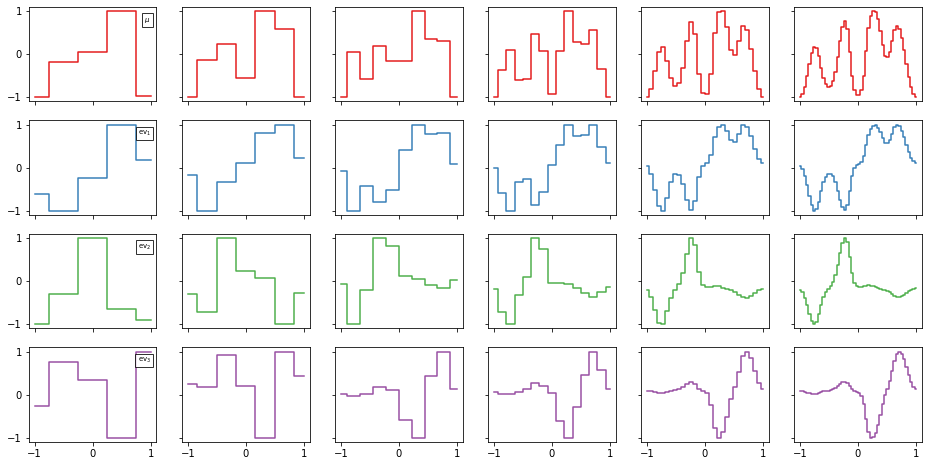MSM on Prinz potential¶
In this example we study the estimation of a Markov state model based on particles living in the Prinz potential landscape.
[1]:
from matplotlib import pyplot as plt
import numpy as np
from deeptime.clustering import BoxDiscretization
from deeptime.markov import TransitionCountEstimator
from deeptime.markov.msm import MaximumLikelihoodMSM
from deeptime.data import prinz_potential
First, we create the Prinz potential system and generate a plot of its potential function.
[2]:
prinz_system = prinz_potential()
xs = np.linspace(-1., 1., 500)
ys = prinz_system.potential(xs)
plt.plot(xs, ys)
plt.xlabel('x')
plt.ylabel('V(x)');

Now we can simulate trajectories for 50 particles, each starting in the origin \(x=0\) and generating 20000 frames.
[3]:
data = prinz_system.trajectory(np.zeros((50, 1)), 20000)
print(f"Output shape {data.shape} for {data.shape[0]} particles, {data.shape[1]} frames "
f"in {data.shape[2]} dimension.")
Output shape (50, 20000, 1) for 50 particles, 20000 frames in 1 dimension.
A histogram over the obtained data reflects the (inverse) potential landscape.
[4]:
plt.hist(np.concatenate(data), bins=150);

We want to generate a sequence of MSMs under lagtime \(\tau=2\) and varying accuracy regarding the spatial clustering.
[5]:
lag = 2
n_clusters = [5, 7, 10, 15, 30, 50]
Each number of clusters yields a discretization which we use to build a MSM.
[6]:
clusterings, msms = [], []
for n in n_clusters:
cluster = BoxDiscretization(1, n, v0=[-1], v1=[1]).fit_fetch(np.concatenate(data))
clusterings.append(cluster)
dtrajs = [cluster.transform(x) for x in data]
count_model = TransitionCountEstimator(lag, 'sliding').fit_fetch(dtrajs)
msm = MaximumLikelihoodMSM().fit_fetch(count_model.submodel_largest())
msms.append(msm)
We can now look at different properties of the estimated MSMs.
The transition matrices from coarse to fine with states ordered from left to right in configuration space:
[7]:
f, axes = plt.subplots(nrows=2, ncols=int(len(msms)//2), figsize=(8, 5))
for ax, msm in zip(axes.flatten(), msms):
ax.imshow(msm.transition_matrix, cmap=plt.cm.Greys)
ax.set_xticks([])
ax.set_yticks([])
ax.set_title(f'n = {msm.n_states}')

The stationary distribution and first three nontrivial eigenfunctions:
[8]:
n_eigenfunctions = 4
cmap = plt.cm.Set1
f, axes = plt.subplots(nrows=n_eigenfunctions, ncols=len(msms), figsize=(16, 8), sharex=True, sharey=True)
finest_cl = clusterings[-1]
finest_msm = msms[-1]
for n, (msm, cluster) in enumerate(zip(msms, clusterings)):
eigenvectors = msm.eigenvectors_left()
for eig_n in range(n_eigenfunctions):
ax = axes[eig_n, n]
y = eigenvectors.T[:, eig_n]
y = 2*(y-y.min())/(y.max() - y.min()) - 1 # rescale
y0_ = finest_msm.eigenvectors_left().T[:, eig_n] / finest_msm.eigenvectors_left().T[:, eig_n].max()
y0 = np.interp(cluster.cluster_centers[:, 0], finest_cl.cluster_centers[:, 0], y0_)
if ((-y-y0)**2).sum() < ((y-y0)**2).sum():
y = -y
ax.step(cluster.cluster_centers[:, 0], y, color=cmap(eig_n), where='mid')
if n == 0:
lbl = r'$\mu$' if eig_n == 0 else r'$\mathrm{{ev}}_{{{}}}$'.format(eig_n)
props = dict(boxstyle='square', facecolor='white', alpha=.8)
ax.text(1., .9, lbl, verticalalignment='top', horizontalalignment='right',
bbox=props, fontsize='x-small')

And finally, the timescales depending on the coarseness of the MSM.
[9]:
length = n_eigenfunctions - 1
ys = np.arange(length)
f, ax = plt.subplots(1, 1, figsize=(8, 2))
for n, msm in enumerate(msms):
colors = []
for i in range(length):
colors.append(list(cmap(i+1)))
colors[-1][-1] = ((n+1+len(msms))/(2*len(msms)))
ax.scatter(msm.timescales(k=length), ys, c=colors, marker='s', s=15)
ax.semilogx()
ax.set_ylim(-.5, 2.5)
ax.spines['right'].set_visible(False)
ax.spines['top'].set_visible(False)
ax.spines['left'].set_visible(False)
ax.set_xlim(.91, 1.99e2)
ax.set_yticks([])
for n in range(3):
ax.text(0.91, n, r'$\mathrm{{ev}}_{{{}}}$'.format(n+1),
va='center', ha='left', fontsize='x-small', rotation=90)

